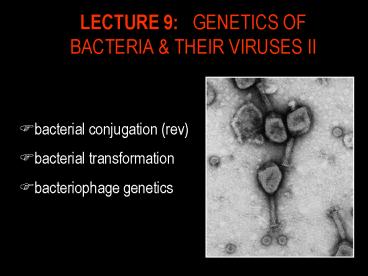LECTURE 9: GENETICS OF BACTERIA - PowerPoint PPT Presentation
1 / 34
Title:
LECTURE 9: GENETICS OF BACTERIA
Description:
LECTURE 9: GENETICS OF BACTERIA & THEIR VIRUSES II bacterial conjugation (rev) bacterial transformation bacteriophage genetics BACTERIAL CONJUGATION interrupted ... – PowerPoint PPT presentation
Number of Views:143
Avg rating:3.0/5.0
Title: LECTURE 9: GENETICS OF BACTERIA
1
LECTURE 9 GENETICS OF BACTERIA THEIR
VIRUSES II
- bacterial conjugation (rev)
- bacterial transformation
- bacteriophage genetics
2
BACTERIAL CONJUGATION
- interrupted-mating
- selective markers
- donor is strs
- recipient is strr
- origin of replication transferred first
- 1st transferred markers most frequent in
exconjugants
3
BACTERIAL CONJUGATION
- bias in recovery of markers
- gradient of transfer used for determination of
gene order only
4
Schaums Outlines Genetics 3rd Ed., CH12, pp.
321 325 4th Ed., CH10, pp. 349 355
5
BACTERIAL CONJUGATION
- exogenote enters cell ... merozygote partial
diploid - single recombination event (3x, 5x, ...)
nonviable - double recombination event (4x, 6x, ...) viable
6
BACTERIAL CONJUGATION
- bias in recovery of markers
- gradient of transfer used for determination of
gene order only - ? to determine map distances, select late marker
to ensure transfer of all relevant genes ... high
resolution mapping
7
BACTERIAL CONJUGATION
- high-resolution mapping by recombinant frequency
8
Schaums Outlines Genetics 3rd Ed., CH12, pp.
321 325 4th Ed., CH10, pp. 349 355
9
TRANSFORMATION IN BACTERIA
- conversion of one genotype to another by uptake
of exogenous DNA - transformation principle demonstrated that DNA
was responsible for inherited differences in
polysaccharide character of S. pneumoniae (CH8)
10
TRANSFORMATION IN BACTERIA
- extracted DNA (in an experiment) breaks at random
- co-transformation of 2 tightly linked donor genes
is more likely than 2 distant donor genes - cells must be made competent to enable DNA entry
- detergents
- electrical fields
11
TRANSFORMATION IN BACTERIA
- dependent on concentration of DNA in the medium
12
TRANSFORMATION IN BACTERIA
- DNA must enter and recombine into the host
13
TRANSFORMATION IN BACTERIA
- practice question, p. 237, 18
14
BACTERIOPHAGE GENETICS
- bacteriophage eaters of bacteria
- T-phages well studied T-even and T-odd
15
BACTERIOPHAGE GENETICS
- bacteriophage eaters of bacteria
- T-phages well studied T-even and T-odd
16
BACTERIOPHAGE GENETICS
17
BACTERIOPHAGE GENETICS
- lysis breaking of cell wall and release of
phage particles - bacteriophage lytic cycle ...
18
BACTERIOPHAGE GENETICS
- phage plaques on a lawn of bacteria
- 1 plaque forming unit PFU 1 phage particle
- plaque morphology
- host range
19
BACTERIOPHAGE GENETICS
- phage cross
- h r x h r
- h infect strain 1
- h infect strains 1 2
- r slow lysis, small plaques
- r slow lysis, large plaques
20
BACTERIOPHAGE GENETICS
- lawn of 2 E. coli strains 1 immune to h phage
21
BACTERIOPHAGE GENETICS
- phage cross
- h r x h r
- h clowdy
- h clear
- r small
- r large
- RF h r h r
- TOTAL
22
TRANSDUCTION IN BACTERIA
- alternative life cycles of temperate
bacteriophage
23
TRANSDUCTION IN BACTERIA
- generalized transduction random incorporation
- lytic cycle, non-integrated phage
24
TRANSDUCTION IN BACTERIA
- co-transduction
- donor leu thr azir ? recipient leu thr azis
25
TRANSDUCTION IN BACTERIA
- genetic map of the purB ? cysB region in E. coli
26
TRANSDUCTION IN BACTERIA
- phage integration
27
TRANSDUCTION IN BACTERIA
- specialized transduction non- random
incorporation - lysogenic cycle, integrated phage
28
TRANSDUCTION IN BACTERIA
- specialized transduction non- random
incorporation - lysogenic cycle, integrated phage
29
TRANSDUCTION IN BACTERIA
- transduction phage acquire host genes and
transfer them to other bacterial cells - generalized transduction transfers any host
gene and occurs when phage randomly package host
DNA - specialized transduction faulty separation of
prophage (phage incorporated into host genome)
new phage contains adjacent host genes only
30
GENETIC MAPS IN BACTERIA
- E. coli linkage map (minutes)
31
GENETIC MAPS IN BACTERIA
- 5 minutes of the E. coli linkage map
32
GENETIC MAPS IN BACTERIA
- correlated genetic and physical maps in E. coli
33
SUMMARY RECOMBINATION IN BACTERIA
34
BACTERIAL CONJUGATION AND RECOMBINATION MAPPING
PROBLEMS
- in Griffiths chapter 5, beginning on page 179,
add these questions to those listed at the end of
lecture 8 4, 14, 16-21, 24, 28 (eg. in
class)-32 - begin with the solved problems on page 177 if you
are having difficulty - look Schaums Outline (pp. 358-9)
- try Schaums Outline questions 10.7 10.12































